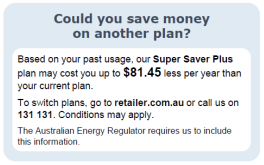Finding a better energy deal should now be easier than ever for Aussie households and small businesses, thanks to the launch of the energy regulator’s long-discussed Better Bills Guideline.
The guidelines, which came into effect on September 30, 2023, see energy retailers required to highlight important aspects of billing information, such as costs and energy usage, in a simpler way, to avoid confusion for consumers.
It has also seen the introduction of a ‘best offer’ message on the first page of billing, to warn energy consumers if they may be paying more than they need to for power with their retailer. This messaging was previously only mandatory in Victoria.
The Better Bills Guideline was originally proposed by the Australian Energy Regulator (AER) in late 2021 and affects customers across New South Wales, Queensland, South Australia, the Australian Capital Territory and Tasmania.
AER Chair Clare Savage said the new billing format was a critical step in ensuring consumers can not only navigate their energy bills but also actively participate in the market.
“Now, more than ever, consumers must have the information they need, presented in a way they can easily understand, to ensure they can make informed decisions about their energy plan,” she said. “These new billing obligations provide clarity and transparency for consumers.”
Ms Savage also said consumers are encouraged to compare plans from other providers, using this new information as a stepping stone to compare.
So, what will energy bills look like now?
The main changes to energy bills will be around the language used and best offer messaging on the front of the bill.
According to the AER, retailers are now required to use plain language when discussing costs and usage amounts, as well as how the retailer calculated these costs for the consumer. All important billing information, such as these costs and how to pay, will be showcased on the first page of the bill.
As for the new best offer messaging, this will need to clearly state if the customer could be on a better deal with the retailer, based on that customer’s past energy usage. This callout will need to state how much, in dollars, a customer could save per year if they were to switch and include the required steps for switching to the cheaper plan.
The best offer message will also be displayed on the first page of the bill.
We’ve included an example of what the new best offer messaging may look like on your bills below, courtesy of the AER:

Will best offer messaging help to reduce bill shock?
While it may not be able to prevent a big bill shock on a customer’s current bill, the introduction of best offer messaging for households in NSW, QLD, SA, ACT and TAS could see future big bills stopped in their tracks.
Canstar Blue Utilities Editor Tara Donnelly said the new billing format provided consumers with the incentive to compare plans and avoid paying more than they need to for power.
“Having a best offer message displayed with a dollar amount can help households to understand more easily how much they could be saving,” she said.
A recent report from Victoria’s independent energy regulator, the Essential Services Commission (ESC), found that one in two Victorian households were sitting on their retailer’s ‘best offer’ in 2022-2023.
The same report found that of those not on their retailer’s best offer, 28% could have saved $100 or more by switching to their retailer’s best offer, 6% could have saved between $250 and $400 and 6% could have saved more than $400.
Ms Donnelly said the Victorian report should inspire consumers in NSW, QLD, SA, ACT and TAS to utilise their new best offer messaging, particularly as the first of the quarterly bills, following the July 1 price changes, start arriving for households.
“Best offer messaging has proven very effective in Victoria, especially when it comes to showcasing the potential savings on offer to consumers,” she said. “Some residents in the state could have saved as much as $400 according to data from the regulator, simply by switching from their current plan to the retailer’s best offer.
“With potential bill shock on the horizon for many Aussies, now could serve as the perfect time for consumers to utilise the newly introduced best offer messaging, not only to compare savings with their current retailer, but also to make sure they aren’t missing out on a better deal with a different provider.”
Image credit: Tikhonova Yana/Shutterstock.com


Share this article